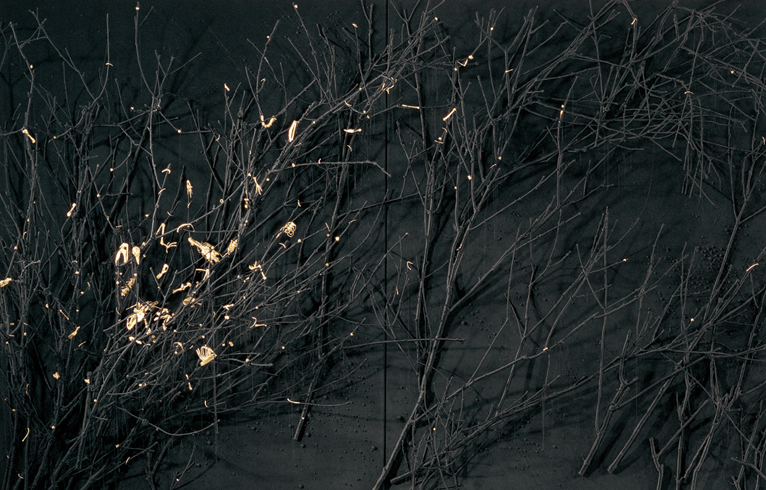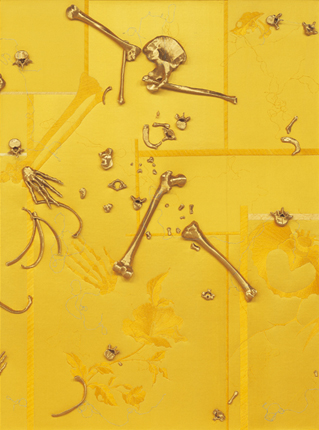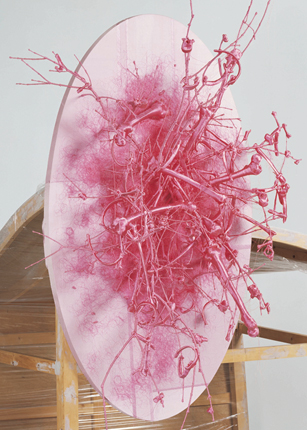THE LOGIC OF THE SAME: ON LIN TIANMIAO’S NEW WORK
| February 8, 2012 | Post In LEAP 12

The countdown to the opening of the solo exhibition has already begun, but Lin Tianmiao’s basement studio in Tongzhou, just east of Beijing proper, remains extremely quiet. Recently and nearly completed artworks render the huge space crowded, and the workers quietly attending to their tasks heighten the tension within the white walls. The moment of final preparation has arrived, and Lin is still pondering her last work.
The exhibition will feature a series of works that Lin Tianmiao began last September. Lin had spent the year before that searching for a new direction, until finally she created a piece provisionally dubbed “the same for N times,” a large piece of cloth embroidered with layer upon layer of densely packed multi-colored insects, animals, and skeletons. The piece has a radiative appearance, akin to the scene of an explosion, alluding to both the Big Bang, the universe’s start, and the universe’s end. Later, after the incident at the Fukushima nuclear power plant, Lin began exploring biological deviations caused by nuclear radiation, raising questions of destruction, reorganization, and new life. It was at this point that form, content, and concept came together, and Lin found her new direction.
Any discussion of Lin Tianmiao cannot avoid beginning with the issue of women in art. If anything, discussions of this issue are too rare in China, and it is the lack of sufficient discourse on this topic that leads to widespread misunderstandings and exacerbates the marginalization of female art. Lin’s 2008 solo exhibition at the Long March Space in Beijing, “Mother’s!!!” saw the artist address feelings of entanglement and helplessness from her personal perspective as a middle-aged woman. Through its expression of Lin’s individual character, the exhibition achieved resonance on a widespread level. In “Gazing Back,” Lin’s 2009 solo exhibition at Shanghai Pujiang Overseas Chinese Town, Lin directly responded to universal women’s issues. At the time, the curator, Huang Zhuan, wanted Lin to produce something bigger and broader in concept. Lin, drawing on the diverse and abundant attitudes and identities of the women of different ages within her own circles, created Badges. After that, Lin felt ready to move past the question of female art and begin a new stage in her work. However, casting aside an old framework does not necessarily mean a new direction and purpose will immediately appear; Lin spent more than a year searching for a breakthrough.

Dissolution, division, choice, synthesis, elimination, death, reorganization, regeneration— these are the ideas that Lin Tianmiao has spun and weighed in her mind as she created new works over the past year and a half. Merely five or ten years ago, these issues seemed far removed from the lives of ordinary people. But today, questions about the safety and regeneration of air, water, food, and the environment in general, as well as the various related political issues, have become an unavoidable reality for everyone. The ubiquitous pressure of these issues partially explains why Lin is attempting to use her own language to describe and express her reflections and vexations. At the same time, the unruly space at the Beijing Center for the Arts provides an additional challenge for the exhibition planning. Lin, who is accustomed to relying on her intuition and instincts to produce an exhibition while leaving the planning to the end, had no choice but to adapt. She has thus considered the organizing thread of this new series of works and established a narrative logic and a framework for display.
The root of this logic is a radical egalitarianism: “I” (starting with the individual and extending to all of humanity) am akin to plants, animals, and even tools. This is the basis of all reorganization and regeneration. This equality is not unrelated to Lin Tianmiao’s frequent interaction with various animal skeletons in her recent work: “All animals, no matter how small, have roughly the same number of bones as the most massive of animals. The complexity and intricacy of the skeleton does not decrease with size.” This observation led Lin to begin to see all animals in the same light, a light which soon expanded to encompass all living and man-made things. Drawing on this notion of equality and the related theme of reorganization, Lin has created a series of objects with visual presentations redolent of archeological discovery: various compounds of man-made and biological (human and animal) forms. Spare parts and skeletons, grafted together with silk thread, form new objects. When these different objects are correctly or even fortuitously combined, they emit a highly stimulating visual and functional energy.
One phrase— “the same”— was not enough to create a complete language, so Lin Tianmiao deliberately left room for further deliberation and exploration. Under the premise of “the same,” each object is responsible for completing and answering the various questions raised by this concept. In the eight-part piece One And The Same? Lin not only experiments with a new creative composition, but also allows the content to initiate a microscopic discussion: tiny differences separate apparently similar works, suggesting that, as in human culture, the tiniest of formal differences can incur the greatest of costs.
Upon further examination, “the same” is in fact “not the same”; the purpose of emphasizing “the same” is to lead to other directions, possibilities, and supplementations. Regarding the levels that “the same” might achieve, Lin Tianmiao analyzed ten possibilities and concocted visual presentations of each. These possibilities, once translated into Lin’s language system, become the headings later applied to the various works in the series: all the same; the very same; the same for N times; more or less the same; just/must be the same; one and the same, two and the same, three and the same…; and others defined by different moods: the black sameness; the grey sameness; and the gold sameness.

A surprising magnificence and delicacy is the greatest visual characteristic of these artworks. Through bundling, covering, connecting, piling and other techniques, Lin Tianmiao applied a tremendous amount of handwork to the creation of a dense world rich in visual impact. From another perspective, this unbridled exaggeration and accumulation is a manifestation of the hyperbolic extravagance and greed of contemporary society. It is no coincidence that these works may make some people uncomfortable. Lin intends for her highly rational and precise visual designs to achieve a maximum of feeling, one that must be able to form a physiological experience of culmination. This so-called culminant experience establishes a direct channel between aesthetic and physical experience, and as its literal meaning implies, it must disappear following its arrival.
One purpose of the use of color is the pursuit of visual extremes. Lin Tianmiao is an artist who cares a lot about control, and she has always been temperate in the use of color in her past works, only utilizing highly neutral colors such as white and gray. The use of multiple colors in these new works constitutes a new approach for Lin. But rigorous control is still evident here, and she adheres to her principles in pursuing the experience of culmination. Especially in her use of pink and gold, Lin accurately anticipates viewers’ physiological and psychological reactions.
Her use of color in this series of artworks allows for a completely systematic interpretation. Pink is an unstable, easily fading color that also represents different explications among the male and female sexes. Lin fashions this kind of ambiguous and ephemeral character into an extraordinarily beautiful and yet fleeting sensation. Black and gray are both neutral colors in Lin’s system, but the emotions they represent differ. Black has a kind of Eastern quality, and its ostensible simplicity in fact belies a richness of layering. For “the same blackness,” Lin, searching for a completely non-reflective, ultimate black, found an expensive variety of light-absorbing wool. She then paired it with the most exquisite of animal skeletons— snake and lizard joints, sparrow heads, bat vertebrae and cicada wings— as well as good leaf, bringing forth an extreme sensitivity and a corresponding poetic sentiment. Gray is speed and accumulation, a manifestation of industry and artificiality, a depressing, concrete heaviness. Gold is most interesting of all. The splendor and wealth it represents are pursued by everyone, but as a color, it is neutral— no different from black, white, or gray. In terms of materials, Lin chose costly pure gold leaf and applied it by hand. In this process, she was once again inspired by the material itself, discovering gold’s personality: though gold is not cloth, it is even more flexible and pliable. It is both eternal and difficult to control, qualities that seem to satirize those who pursue it: you cannot truly possess me, because you cannot truly control me, and I am more eternal than you. In other words, gold belongs only to itself.
A month before the exhibition opening, Lin Tianmiao was still undecided about the final form of “the gold sameness.” The work already included more than a thousand miniature people fashioned out of gold leaf, as well as human bones densely bound in gold thread. Perhaps, at the last minute, Lin will overturn everything, but that would not negate her earlier efforts. Because in the end, Lin’s creative goal is extremely direct: to apply precise expression and control of materials to the exploration of new visual possibilities.


